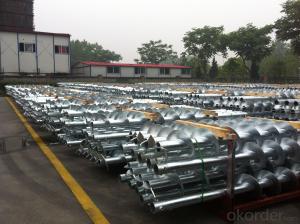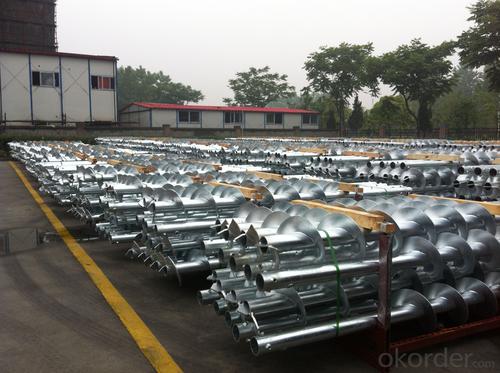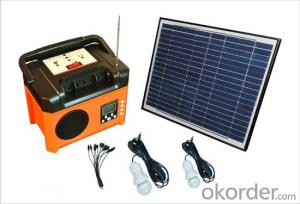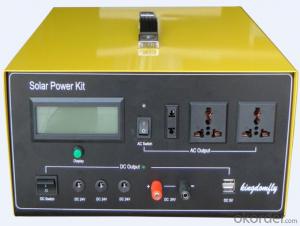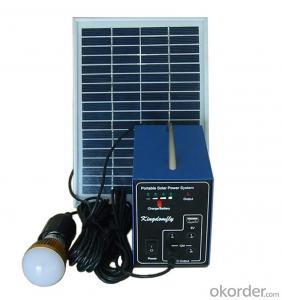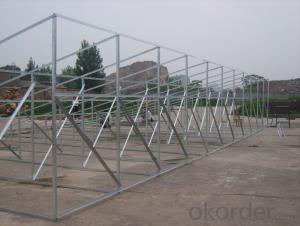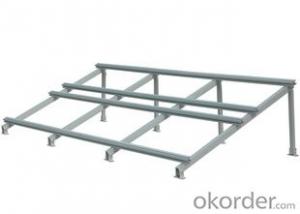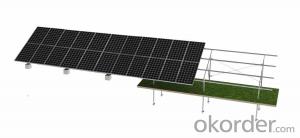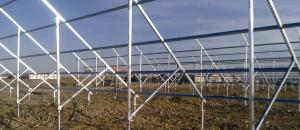Solar Energy Systems Brooklyn NY Solar Mounting System Screw Pile
- Loading Port:
- China Main Port
- Payment Terms:
- TT OR LC
- Min Order Qty:
- -
- Supply Capability:
- -
OKorder Service Pledge
OKorder Financial Service
You Might Also Like
Packaging & Delivery
Packaging Detail:Normal package seaworthy
Delivery Detail:15 days
Specifications
Easy installation Competitive price TUV&SGS test report & CSA certification 15-warranty
Specifications
1) Super smooth beautiful appearance,outstanding quality,large supply.
2) Available in customized surface finishes.
3) Well machined,for example,cutting,drilling and milling with excellent tolerance.
4) Meet with customer’s designs and supply you best price.
5)Usages:Supply for solar panel modules.
Technical characteristics
Installation site:
ground,hillside,and grassland
Installation angle
it is based on customers’ requirements
Installation height
it is basedon customers’ requirements
Solar panel type; with or without frame
Components arrangement :horizontal or vertical
Support track
aluminum alloy extrusion
Quality warranty
15 years
Advantages
1)Quick installation: with high degree of pre-installed rate, the system could be easily installed by using galvanized carbon steel rails for PV Stent, and specially designed connection parts of the PV bracket, which could reduce installation time and cost greatly.
2)Offer unmatched durability: with all structural components comprised of high class stainless steel and anodized aluminum alloy, it is designed for 25 years service life and backed by 15 years warranty.
3)Stand up to extreme weather: The SuninTek solar mount is designed to stand up to the extreme weather complied with the AS/NZ 1170 and other international structure load standard by the skilled engineer. The main support components also have been tested to guarantee its structure and load-carrying capacity.
4)Provide broad installation flexibility: These systems accommodate most commercially available framed solar panels , and they can scale easily from small to large, multi-megawatt installations.
5)Diversified Application: The PV mounting system produced can be adopted by various types of PV cells panels which you can find in the market. It can serve for both mini solar power system and huge plant with megawatt capability.
Main features
1. Installation cost savings.
2. Save installation time.
3. Increase the mechanical strength of solar energy mounting to ensure that wind requirements.
4. The outdoor for installation of solar energy.
5. Length can be customized according to customers.
6. Service life of up to 25 years.
7. Products through the international certification.
8. Stent material composition of the galvanized steel and aluminum.
9. 15 years system and structural guarantee.
10.Flexible post spacing withstands different wind & snow loads.
11. High quality material in Aluminium 6005-T5 and SUS 304.
12.Screws and nuts go with every components needed.
13.Mechanical calculation and reliability tested to ensure highest product quality.
- Q: Can solar energy systems be used in areas with high levels of seismic activity?
- Yes, solar energy systems can be used in areas with high levels of seismic activity. However, it is important to design and install these systems with proper engineering considerations and precautions to withstand potential earthquakes. By implementing robust mounting structures, flexible connections, and secure anchoring systems, solar panels can be made resilient to seismic forces. Additionally, regular inspections and maintenance should be carried out to ensure the integrity and safety of the solar energy systems in earthquake-prone areas.
- Q: What are the different types of solar energy systems?
- There are primarily three types of solar energy systems: solar thermal systems, photovoltaic (PV) systems, and concentrated solar power (CSP) systems. Solar thermal systems use sunlight to heat water or air for various applications such as heating homes or generating electricity. PV systems directly convert sunlight into electrical energy using solar panels, which can be used to power homes or businesses. CSP systems use mirrors or lenses to concentrate sunlight onto a receiver, which produces heat that can be used to generate electricity.
- Q: What is the difference between solar thermal and solar photovoltaic systems?
- Solar thermal systems use the heat from the sun to directly heat water or air, while solar photovoltaic systems convert sunlight into electricity using solar panels.
- Q: Can solar energy systems be used in powering scientific research vessels or marine laboratories?
- Indeed, it is possible to utilize solar energy systems for the purpose of powering scientific research vessels or marine laboratories. Solar energy, being a renewable and sustainable power source, can be harnessed through the utilization of photovoltaic panels or solar thermal collectors. The energy requirements of research vessels and marine laboratories are substantial, given the nature of their operations which involve scientific experiments, data collection, and analysis. These activities usually involve the use of equipment like computers, sensors, and laboratory instruments, which necessitate a continuous and dependable power supply. To address this need, solar energy systems can be installed on said vessels or laboratories, providing a clean and efficient source of electricity. Through the conversion of sunlight into electricity via photovoltaic panels, the various equipment and systems on board can be powered. Moreover, any excess energy produced by the solar panels can be stored in batteries to be utilized during periods of decreased sunlight or at night. The utilization of solar energy in these marine environments presents numerous advantages. Firstly, it diminishes reliance on fossil fuels and diminishes the carbon footprint associated with conventional methods of power generation. This is particularly vital in the context of scientific research as it aligns with the principles of environmental sustainability and conservation. Secondly, solar energy systems offer a reliable and autonomous power source. Research vessels and marine laboratories often operate in remote or secluded locations where access to traditional power grids may be limited or non-existent. By harnessing solar energy, these vessels and facilities can generate their own electricity, enabling them to continue their research activities without depending on external power sources. Lastly, solar energy systems necessitate minimal maintenance and have a lengthy lifespan. Once installed, they require minimal upkeep and are capable of withstanding the harsh marine environment. This makes them highly suitable for use in research vessels or marine laboratories, where downtime and maintenance issues can be disruptive to ongoing scientific projects. In conclusion, there is no doubt that solar energy systems can be effectively employed to power scientific research vessels or marine laboratories. They offer a sustainable, reliable, and autonomous source of electricity, thereby reducing the carbon footprint and ensuring uninterrupted research activities, even in remote locations.
- Q: Can solar energy systems generate power at night?
- No, solar energy systems cannot generate power at night as they rely on sunlight to produce electricity.
- Q: What is the impact of snow or hail on solar panels?
- The performance and efficiency of solar panels can be significantly affected by snow or hail. When snow accumulates on the panels, it obstructs sunlight, causing a decrease in energy production. This reduced sunlight exposure leads to a decline in the overall power output of the solar installation. Likewise, hail can cause physical harm to the panels if the ice pellets are large or impact with high velocity. This harm can result in cracks, shattered glass, or internal structural issues. Once the panels are damaged, their ability to convert sunlight into electricity is compromised, leading to decreased efficiency. To minimize the impact of snow or hail, various measures can be taken. In snowy areas, panels can be installed at an angle to facilitate the sliding off of snow, reducing accumulation. Additionally, heating elements can be incorporated into the panels to melt snow and ice. However, these heating systems require additional energy, which may offset some of the benefits of solar power during snowy periods. Regarding hail, the use of tempered or impact-resistant glass for solar panels can help minimize damage. Furthermore, mounting systems that provide flexibility and shock absorption can absorb impact and reduce the risk of physical harm to the panels. In conclusion, although snow and hail can negatively affect solar panels, proper installation, maintenance, and protective measures can mitigate these impacts and ensure efficient generation of clean and renewable energy.
- Q: Can solar energy systems be used in areas with high levels of bird activity?
- Yes, solar energy systems can be used in areas with high levels of bird activity. However, it is important to take certain precautions to ensure the safety of the birds and the optimal functioning of the solar panels. One common concern is the potential for bird collisions with the panels. To mitigate this, manufacturers often incorporate bird deterrents such as mesh screens or reflective coatings on the panels to make them more visible to birds and reduce the risk of collisions. Additionally, proper installation and maintenance of the solar energy systems can help minimize potential nesting or roosting sites for birds, reducing the likelihood of damage to the panels. By addressing these considerations, solar energy systems can be effectively utilized in areas with high bird activity while still protecting the local avian population.
- Q: Are there any risks of electrical hazards during installation or maintenance of solar energy systems?
- During the installation or maintenance of solar energy systems, there are indeed risks of electrical hazards. Working with high-voltage DC electricity in solar energy systems can be dangerous if not handled correctly. Here are some potential risks to be aware of: 1. Electrocution: Incorrect isolation or disconnection of solar panels can lead to electrocution for those working on the system. 2. Fire Hazards: Faulty wiring, loose connections, or improper installation can cause electrical arcs and sparks, potentially resulting in a fire if proper precautions are not taken. 3. Falls and Injuries: Installing solar panels on rooftops involves climbing ladders, working at heights, and handling heavy equipment. Carelessness can lead to slips, falls, and injuries. 4. Arc Flash: Working on live electrical equipment poses a risk of sudden energy release, known as arc flash. This can cause severe burns, hearing damage, and even death. 5. Environmental Risks: Although not directly related to electrical hazards, it is essential to consider environmental risks during solar energy system installation. Improper disposal of hazardous materials used in solar panels, such as lead, cadmium, or other toxic substances, can harm the environment if not handled correctly. To reduce these risks, it is crucial to follow proper safety protocols and guidelines during installation and maintenance. This includes wearing personal protective equipment (PPE), following grounding and isolation procedures, using insulated tools, and adhering to local electrical codes and regulations. Hiring trained and certified professionals for installation and maintenance is also recommended to minimize the risks associated with electrical hazards.
- Q: Can solar energy systems be used for powering streetlights or outdoor lighting?
- Yes, solar energy systems can be used for powering streetlights or outdoor lighting. Solar-powered streetlights and outdoor lighting systems are becoming increasingly popular due to their numerous benefits such as reduced electricity costs, lower environmental impact, and increased efficiency. These systems use photovoltaic panels to convert sunlight into electricity, which is then stored in batteries and used to power the lights during nighttime.
- Q: Can solar energy systems be used for powering off-grid eco-lodges?
- Yes, solar energy systems can be effectively used for powering off-grid eco-lodges. Solar panels can be installed on the roofs of eco-lodges to harness the energy from the sun and convert it into electricity. This renewable source of energy can then be used to power various electrical appliances, lighting, heating, and cooling systems in the eco-lodges. Additionally, solar energy systems can also incorporate battery storage to store excess energy for use during cloudy or nighttime conditions. This sustainable solution not only reduces the reliance on fossil fuels but also minimizes the environmental impact of off-grid accommodations.
Send your message to us
Solar Energy Systems Brooklyn NY Solar Mounting System Screw Pile
- Loading Port:
- China Main Port
- Payment Terms:
- TT OR LC
- Min Order Qty:
- -
- Supply Capability:
- -
OKorder Service Pledge
OKorder Financial Service
Similar products
Hot products
Hot Searches
Related keywords
